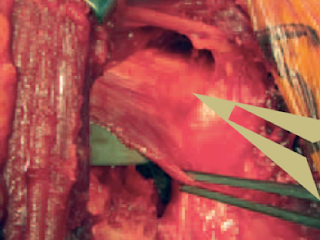Cuff tear arthropathy is a type of shoulder arthritis in which both rotator cuff and the cartilage normally covering the joint are both deficient.
When the patient is unable to elevate the arm above the horizontal, cuff tear arthropathy is often treated using a reverse total shoulder.
However, when active elevation of the arm is present, a humeral hemiarthroplasty with an extended humeral head (the CTA arthroplasty) can provide a safe, effective and less invasive alternative. In this procedure the resurfaced humeral head articulates with the undersurface of the intact coracoacromial arch.
This surgical procedure requires matching of the diameter of curvature of the native humeral head
And preserving the stabilizing tissue covering the anterior aspect of the humeral head.
Appropriate sizing of the humeral head prosthesis can re-tension the deltoid.
This procedure cannot be used when the shoulder has been destabilized by a prior acromioplasty
More about this technique can be seen in this youtube (link).
Here is an example of a shoulder with cuff tear arthropathy before surgery. In spite of the destruction of the joint surface, the patient was able to actively elevate her arm.
Here is an example of a shoulder with cuff tear arthropathy before surgery. In spite of the destruction of the joint surface, the patient was able to actively elevate her arm.
She elected to have a CTA arthroplasty. At surgery she had complete and irreparable failure of her supraspinatus or infraspinatus.
Here is her shoulder shoulder nine years after the CTA arthroplasty, showing remodeling of her coracoacromial arch.
She generously granted permission for us to show her function nine years after surgery.
At an average of 2-years after surgery, there were no complications or revisions. Specifically the complications that have been associated with a reverse total shoulder were avoided: no component dissociations, no baseplate failures, and no dislocations.
The Simple Shoulder Test score improved from a median of 3.0 to 8.0 (P < .001). The median percentage of maximal possible improvement was 50% (P < .001). The percentage of patients able to perform each of the functions of the Simple Shoulder Test was significantly improved; for example, the ability to sleep comfortably increased from 19% to 71%, and the ability to place a coin on the shelf at shoulder level increased from 38% to 86% (P < .001).
Comment: There are circumstances in which reverse total shoulder is clearly the preferred procedure for cuff tear arthropathy, including pseudoparalysis, anterosuperior escape, and glenohumeral instability; however, in shoulders with preserved active motion and stability of the humeral head provided by an intact coracoacromial arch, the extended head humeral arthroplasty can enable selected patients to realize improved comfort and function without the potential risks of RTSA.
Comment: There are circumstances in which reverse total shoulder is clearly the preferred procedure for cuff tear arthropathy, including pseudoparalysis, anterosuperior escape, and glenohumeral instability; however, in shoulders with preserved active motion and stability of the humeral head provided by an intact coracoacromial arch, the extended head humeral arthroplasty can enable selected patients to realize improved comfort and function without the potential risks of RTSA.
===
We have a new set of shoulder youtubes about the shoulder, check them out at this link.
Be sure to visit "Ream and Run - the state of the art" regarding this radically conservative approach to shoulder arthritis at this link and this link
Use the "Search" box to the right to find other topics of interest to you.
We have a new set of shoulder youtubes about the shoulder, check them out at this link.
Be sure to visit "Ream and Run - the state of the art" regarding this radically conservative approach to shoulder arthritis at this link and this link
Use the "Search" box to the right to find other topics of interest to you.
How you can support progress in shoulder surgery
You may be interested in some of our most visited web pages arthritis, total shoulder, ream and run, reverse total shoulder, CTA arthroplasty, and rotator cuff surgery as well as the 'ream and run essentials'











